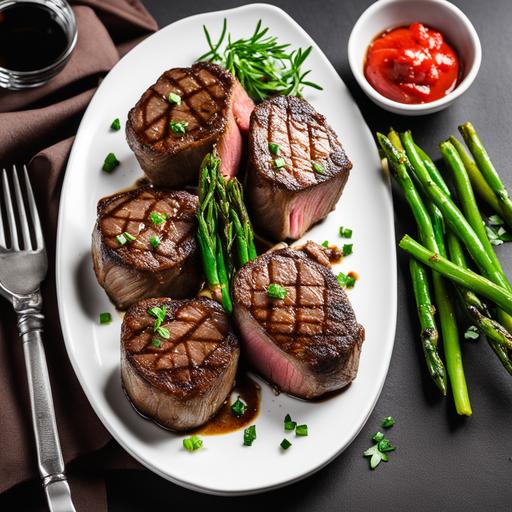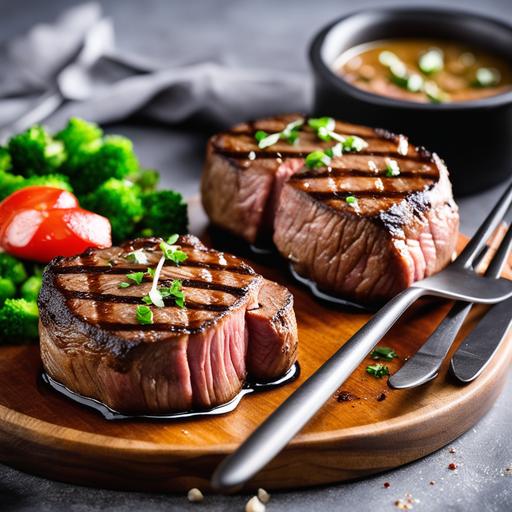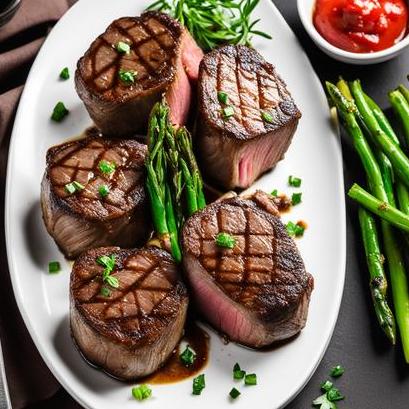
The Perfect Filet Mignon: A Mouthwatering Oven Recipe
When it comes to treating yourself to a special meal, few things rival the delicate tenderness and flavor of a beautiful filet mignon steak. Cooking this cut to perfection might initially seem intimidating, but fear not! In this comprehensive guide, we will delve into the culinary details, food science, selection, cleaning, preparation, tips, variations, doneness checks, and more, all to guarantee a succulent and perfectly cooked filet mignon steak using an oven recipe.
Food Science Behind Filet Mignon
Before we dive into the culinary aspects, it is important to understand the science behind this delectable cut of meat. Filet mignon refers to the tenderloin muscle found within the beef loin. Its tenderness comes from being located in a muscle group that is rarely used during the animal’s life, resulting in a remarkably tender piece of meat. This lack of exercise means less connective tissue and fat content; therefore, it is crucial to protect its delicate nature during the cooking process.
Culinary Details for Divine Steaks
Selecting the Perfect Filet Mignon
When choosing filet mignon steaks, look for those with a vibrant red color, marbled with thin streaks of fat. This marbling enhances both the tenderness and flavor. Opt for cuts that are about 1.5 to 2 inches thick, ensuring a juicy and evenly cooked steak.
Cleaning and Preparing the Steaks
Before preparing your filet mignon steaks, give them a gentle rinse under cold water. Pat them dry using paper towels to remove any excess moisture. This step ensures a gorgeous sear and prevents splattering when they hit the hot pan.
The Magic of Seasoning
Seasoning is essential to enhance the natural flavors of filet mignon. Prepare a dry rub using a combination of salt, freshly ground black pepper, and any other preferred herbs or spices. The simplicity of salt and pepper can allow the natural tenderness to shine, but experimentation with rosemary, thyme, or even a touch of garlic powder can add complementary notes.
Tips for Perfect Preparation
To take your filet mignon to the next level, consider a two-step cooking process: searing and finishing in the oven. Searing provides a caramelized crust with an explosion of flavors while maintaining a tender center. By finishing the steaks in the oven, you ensure uniform cooking and prevent the risk of overcooking.
Searing, the Gateway to Flavor

Choosing the Right Pan
For a successful sear, you need to choose the right pan. Opt for a heavy-bottomed skillet, preferably cast iron, which ensures even heat distribution and retention. This will aid in achieving that delightful golden-brown crust.
Temperature Matters
Before heating your pan, allow your steaks to rest at room temperature, usually around 30 minutes, to ensure even cooking. Preheat the oven to 400°F (200°C) during this time to maintain a consistent temperature for the finishing step later.
The Searing Process
Generously coat your pan with a high smoke point oil like canola or grapeseed oil. Heat the pan over medium-high heat until it is screaming hot but not smoking. Carefully place your seasoned filet mignon steaks into the pan, ensuring they do not overcrowd the cooking surface. Let them sizzle, without moving, for about 2 minutes per side until they develop a gorgeous sear. This process will create a crust that keeps the juicy goodness inside while adding depth of flavor.
Preparing for the Oven
Once your filet mignon steaks have developed that delicious crust on all sides, transfer them to a wire rack set on a baking sheet. The wire rack ensures proper air circulation, promoting even cooking in the oven.
The Oven Finishing Touch

Achieving the Perfect Doneness
The oven provides the opportunity to fine-tune the internal temperature of your filet mignon steaks without the risk of undercooking or overcooking. Insert a digital meat thermometer into the thickest part of the steak. For medium-rare, aim for an internal temperature of 135°F (57°C). Keep in mind that residual heat will continue to cook the steaks while they rest, allowing the temperature to rise a few degrees.
Cooking Time and Resting
Place the baking sheet with the wire rack into the preheated oven. Allow the filet mignon steaks to cook for approximately 8-12 minutes or until reaching the desired internal temperature. Once done, remove the steaks from the oven and refrain from cutting into them straightaway. Tent each steak with aluminum foil and let them rest for 5-10 minutes. This resting period further enhances their juiciness and tenderness.
Checking Doneness without Thermometer
If you find yourself without a meat thermometer, fret not! An alternative method to check the doneness of your filet mignon is by gently pressing the center of the steak with your fingertip. For a medium-rare steak, it should feel soft and slightly springy. A well-done steak will feel firm.
Serving Suggestions and Variations

Pairing with Delicious Sides
When it comes to serving filet mignon steaks, simplicity is key to let the flavors shine. Classic accompaniments include sautéed mushrooms, roasted asparagus, garlic mashed potatoes, or a side salad. Take your pick and create a well-rounded meal to complement the star of the show.
Variations for Adventurous Eaters
While a perfectly cooked filet mignon needs little enhancement, experimenting with different sauces or compound butters can add a delightful twist. Consider a red wine reduction, béarnaise sauce, or a bleu cheese butter to take your filet mignon to new heights.
Overcooking and Undercooking – The Perils to Avoid
Overcooking or undercooking your filet mignon can detract from its potential flavor and tenderness. When overcooked, it can become dry and lose its pleasant texture. On the other hand, undercooking can result in a raw or uncomfortably rare center. By following the recommended cooking times and temperature guidelines, you ensure the perfect balance.
Conclusion
Congratulations! You are now armed with the knowledge and skills to create an exceptional filet mignon steak using an oven recipe. From selecting the finest cuts, seasoning to perfection, achieving a sumptuous sear, and finishing in the oven, each step contributes to the masterpiece that will be your meal. Remember to savor each bite and enjoy the exquisite flavors resulting from your culinary expertise. Happy cooking!
Sources
FAQS On Filet Mignon Steaks Oven Recipe
What Temperature Should I Set My Oven To When Cooking Filet Mignon Steaks?
Preheat your oven to 450°F for a quick and high-heat cooking method. This will help to create a nice sear on the outside of the steaks while keeping the inside tender and juicy.
How Long Should I Cook Filet Mignon Steaks In The Oven?
Depending on the thickness of the steaks, they should be cooked for about 8-10 minutes for medium-rare, or 10-12 minutes for medium. It’s best to use a meat thermometer to ensure the steaks reach an internal temperature of 130°F for medium-rare or 140°F for medium.
Should I Marinate The Filet Mignon Steaks Before Cooking Them In The Oven?
It’s not necessary to marinate filet mignon steaks, as they are already a tender cut of meat. However, you can season them with salt, pepper, and any other desired herbs or spices before cooking.
Do I Need To Let The Filet Mignon Steaks Rest After Cooking Them In The Oven?
Yes, it’s important to let the steaks rest for about 5 minutes after removing them from the oven. This allows the juices to redistribute throughout the meat, resulting in a more flavorful and juicy steak.
What Side Dishes Pair Well With Filet Mignon Steaks Cooked In The Oven?
Classic side dishes such as mashed potatoes, roasted vegetables, or a light salad pair well with filet mignon steaks. You can also consider serving them with a creamy mushroom sauce or a red wine reduction for added flavor.



